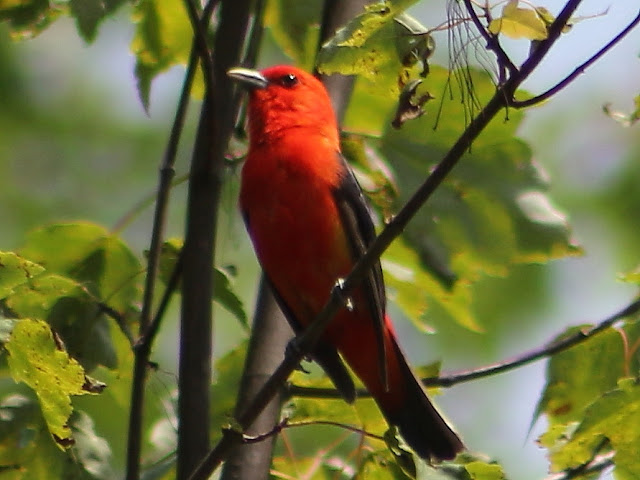Last week I came across a Veery nest on the ground. The incubation period for Veeries is about 12 days, so I went back on Thursday to check on its status. Last year a ground nest was destroyed so I wasn't sure what I would find, but was pleased to see the nest intact and the first egg had hatched.
 |
| One of the four eggs has hatched. |
By the appearance of the tiny chick it must have just hatched; there was no sign of the other three eggs starting to crack. Mother veery keeps a neat house as she had already removed the egg shells. I'd love to go back in two or three days to see if the other eggs have hatched, but I'll resist the urge in order to minimize disturbance. The veery nesting period is 10-12 days so I'll check next week to learn whatthe status of all the eggs.
The blueberries ripened up nicely in the hot weather this week and should remain plentiful for at least another week. With a little luck you'll gather some before the birds and chipmunks get them all. A large flock of Common Grackles was raiding this blueberry bush and feeding them to their young, sometimes two at a time.
 |
| Common Grackle with a mouthful of blueberries; its offspring waits beside. |
The Annual Loon Census sponsored by the Loon Preservation Committee occurred yesterday. Volunteers and professionals alike went out on many of New Hampshire's lakes between 8:00 and 9:00 am to determine how many loons are in the state. Five loons were counted on Wicwas this year: The single banded male in the northern territory and the family of four in the southern territory. The two chicks, Spangle and Star are doing well, and Spangle is starting to dive. They might not catch their own food for quite a while, but it might help them avoid predators from above such as eagles.
There is a dramatic difference in the size of the two chicks - Spangle looks to be almost twice the size of Star.

This photo taken by Dave Thorpe during the loon census hints at why, and indicates that it may take Star some time to catch up.
The mid-summer wildflowers are starting to take over the flower show now. Daisies are going by but Black-eyed Susans are coming on strong and the evening primrose are starting to bloom.
 |
| Evening Primrose |
I try to remember to check these in the morning, looking for the Primrose Moth. If I see one I'll share it here.
I was treated to a rare sighting of a Scarlet Tanager yesterday when it flew down from the high tree tops and into my sight. I've been hearing it for weeks, always looking for it, but he is way up high, hidden amongst the leaves. I had been listening to him sing for a long time, unable to find him when suddenly something attracted him down to a Red Maple tree right in my sight where he perched for several minutes.
Let's end with a dragon - one of the most brilliantly colored of all the dragonflies.
 |
| Eastern Pondhawk |
Bright scarlet birds and emerald green dragonflies - the variety of nature's creations is endless.
Correction: Jen Esten and Jon Waage, authors of the The Nature of Pleasant Lake blog, observed that the mustelids in last week's video were likely River Otters. Checking with the photographer about the location of the video supports otter as the correct identification. Thank you Jen and Jon!






No comments:
Post a Comment